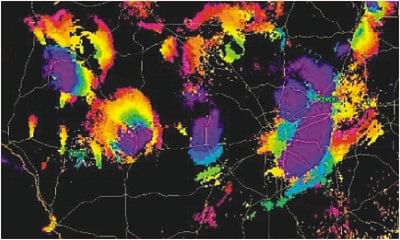Bat swarm portent of weather

Radar images show masses of bats moving across the landscape (color bar below shows movements over time)
The blips and blobs caused by flying animals may look like noise to storm-watchers studying Doppler radar data, but these signals could be a big hit with bat biologists.
Bats swirling out of caves show up on weather radar, as do masses of birds and other flying animals. Now that the National Severe Storms Laboratory in Norman, Okla., is merging its radar data onto a single nationwide frequently updated map, biologists have an opportunity to get a new view of aerial creatures, said ecologist Winifred Frick of the University of California, Santa Cruz. She presented a preview of biological studies using the stitched together Doppler data on February 19 at the annual meeting of the American Association for the Advancement of Science.
Biologically speaking, the air is "a very unexplored part of our biosphere," said Thomas Kunz of Boston University. Kunz, a bat biologist, has christened this emerging discipline "aeroecology."
At the meeting, Frick described how, in a radar sequence from southern Texas, she had seen something she had never imagined: swarms of bats following an evening weather front. "Radar is like a really fancy pair of binoculars," Frick said.
In the radar view of a storm front rolling over Texas, Frick pointed out a frayed tan bar indicating insect swarms moving with the air mass. The radar doesn't reveal much about the identity of species in a cloud, but Frick knew that the front was passing over a bat cave. A yellow burst on the radar showed what Frick identified as dense crowds of Brazilian free-tailed bats speeding out of their cave at sunset to hunt for insects. The burst bloomed into a cloud of bats, with an elongated mass sliding west along with the bugs. "It's a big aerial buffet line," Frick said.

 For all latest news, follow The Daily Star's Google News channel.
For all latest news, follow The Daily Star's Google News channel. 



Comments